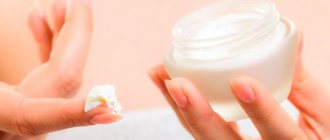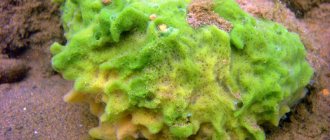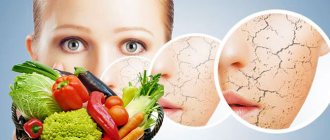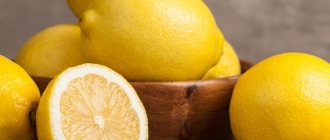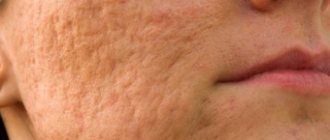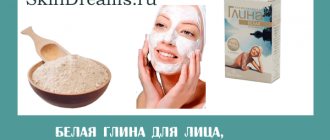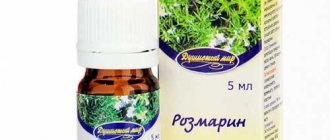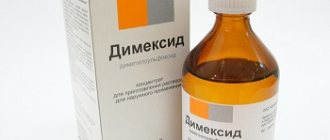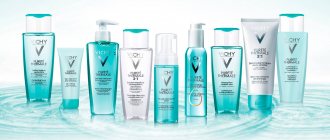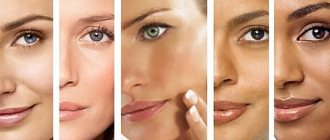Not every girl can boast of a perfectly even skin tone.
A properly selected anti-acne cream will help eliminate the effects of pimples and acne.
These products contain a whole range of active ingredients that help lighten spots and start skin regeneration processes.
Features of the composition
To quickly solve the problem, you need to choose the best anti-acne cream. The product must contain the following ingredients:
- Arbutin and hydroquinone are whitening ingredients that help lighten the dermis. Thanks to this, the skin acquires an even color and spots become less noticeable. In addition, these substances reduce the synthesis of melanin, which is responsible for regulating pigmentation.
- Acids – kojic, lactic, salicylic, citric . All these ingredients help exfoliate dead cells that are responsible for staining. Acids help make your face clearer and fight blemishes.
- Azelaic acid is another effective ingredient that successfully treats acne symptoms.
- Antibacterial and antiviral ingredients - help cleanse the skin and protect against inflammation.
- Zinc oxide – provides cell exfoliation, helping to cope with acne marks and rashes.
- Collagen and elastin restore the elasticity of the dermis and help smooth its surface, removing unevenness.
- Moisturizing and nourishing ingredients reduce the negative effects of external factors that dry out the skin and destroy its protection.
- Plant extracts - chamomile, calendula, tea tree, St. John's wort. All these components successfully cope with inflammation and reduce the symptoms of pigmentation.
- Essential oils have a beneficial effect on the condition of the dermis.
Reviews
- Alina, 25 years old: “I struggled with acne for a long time, but when I got rid of the disease I did not experience joy, because my whole face was covered with post-acne. I decided to do carbon cleaning - the procedure went without any problems; during laser treatment I felt a slight tingling sensation. After the first cleansing, my face felt fresh, and after the course I was able to get rid of my problem.”
- Elena, 27 years old: “When I was a teenager, my friends were jealous of my clean face. The trouble came when we didn’t expect it – acne appeared at the age of 25. I was able to cure the disease and its consequences only with the help of professional cleansing with salicylic acid.”
- Svetlana, 29 years old: “Microdermabrasion helped me get rid of post-acne. Honestly, the sensations during the procedure are very unpleasant, but the result is worth it - now my face is smooth, elastic and clean.”
Do not forget that peeling of scars can be done only after acne is completely cured and inflammatory processes are eliminated. A variety of types of chemical therapeutic peeling for scars will allow you to choose the best option, taking into account your skin type and severity of the problem.
Rating
Beneficial features
Ointments and creams for post-acne have different effects - it all depends on their composition. Most often they allow you to achieve the following results:
- accelerate collagen synthesis,
- improve blood circulation,
- strengthen the immune system,
- normalize water balance,
- cope with bacterial microorganisms.
Any cream for scars and post-acne should provide:
- reducing the size and thickness of the scar,
- lightening the shade,
- eliminating skin tightness,
- softening the scar.
To achieve the most effective results, the use of the cream should be started when the scars and blemishes are still fresh.
This will help get rid of the feeling of itching and redness, as well as stop the abnormal process.
Risks of using hydrogen peroxide
There are a number of risks associated with using hydrogen peroxide as an acne treatment.
Skin irritation
Hydrogen peroxide can be a skin irritant, which can be harmful for acne-prone skin. Research shows that inflammation is an important factor in the development of acne, and irritation can cause inflammation. This may increase redness, itching and pain.
Delays healing of damage
Research shows that hydrogen peroxide can reduce infection, but in some cases it may delay wound healing.
Dangerous for wounds
In rare cases, using hydrogen peroxide on wounds can cause an oxygen embolism, which is life-threatening. This occurs when a blood vessel is blocked by an air bubble.
Effective pharmaceutical products
Today in pharmacies you can find quite a lot of effective products that can quickly eliminate traces of acne and acne.
Contractubex
This product contains allantoin, sodium heparin, and Serae onion extract . Thanks to this, the drug has an anti-inflammatory effect, stops tissue development and promotes the production of more collagen.
This product helps to cope with minor skin defects . In combination with ultrasound exposure, Contractubex is used to smooth the surface of the epithelium after acne.
Kelofibrase
This drug has an anti-inflammatory effect, accelerating blood circulation.
With its help, it is possible to restore water balance. The active ingredients of the drug are urea and heparin .
Scar Fix
This is a liquid cream that includes hydrocortisone, vitamin E and silicone . After application, a film is formed on the skin, which ensures tightness and regeneration of dermal cells.
For long-term therapy, the product should be applied twice a day.
Avene Cleanance Diacneal
This substance helps eliminate irritation and soften the skin.
The main task of the product is to exfoliate the stratum corneum of the dermis, which improves the structure of the epithelium, narrows pores and cleanses blackheads.
Sledotsid
This cream-gel helps eliminate congestion in the skin structure and hyperpigmentation that occurs after acne. Thanks to its use, it is possible to lighten dark areas of the dermis.
The product also has a healing effect, helps smooth out the surface of the face and gives it a natural shade.
Baziron
The active component of the product is benzoyl peroxide . This is an anti-inflammatory ingredient that regulates the functioning of the sebaceous glands. Thanks to this, the oiliness of the dermis is reduced and the pores of the face are cleansed.
The drug has a keratolytic effect and promotes the dissolution of comedones. It is important to take into account that the cream dries out the skin , and therefore should not be used by people with dry skin.
Bepanten
The main component of the product is dexpanthenol - provitamin B5 . With the help of this substance, it is possible to start the process of regeneration of the dermis and mucous membranes, increase the strength of collagen fibers and speed up metabolism in the skin.
Bepanten cream has pronounced anti-inflammatory and antimicrobial properties. Thanks to its use, it is possible to soften the skin and prevent the appearance of scars and scars after acne .
Skinoren
The main property of this remedy is to eliminate inflammation in enlarged pores of the face. It is the clogging of pores and the entry of infections into them that causes acne, which leaves behind unsightly spots.
Skinoren cream helps exfoliate dead cells that interfere with skin breathing.
It is important to take into account that the product does not have an immediate effect. At the same time, systematic use of the medicine allows you to cope with redness, irritation and peeling of the skin.
Pathogenesis
The greatest significance in the pathogenesis of the formation of the post-acne symptom complex is the depth of damage to the skin. Thus, the phenomena of pigmentation/erythema are the result of trauma to the epidermis, while scars are the result of destructive processes in the dermis.
Damage (alteration) of the skin is a trigger for a cascade of reactions in the wound process, which occurs in several stages:
- Inflammation. At this stage, primary vasoconstriction (compression of blood vessels) is replaced by their expansion (vasodilation) and against this background, stimulation of the process of melanogenesis and the formation of inflammatory stagnant spots/dispigmentations can occur.
- Formation of granulation tissue. At this stage, neovascularization (capillary growth) is noted, fibroblasts begin to synthesize new collagen, and as the scar matures, the ratio of type III to type I collagen changes. keratinocytes begin to actively proliferate , which, migrating into the wound, participate in the process of removing fibrinoid exudate.
- Matrix remodeling. This stage is characterized by matrix reconstruction. Enzymes synthesized by fibroblasts and keratinocytes, in particular those responsible for the architecture of the extracellular matrix, metalloproteinases/tissue inhibitors, contribute to the lytic cascade of reactions of the intercellular substance. That is, an imbalance of metalloproteinases and their tissue inhibitors leads to the development of atrophic/hypertrophic scars.
Propionic acne bacteria (propionebakterii akne) also play an important role in the formation of scars.
Useful Home Remedies
To cope with the effects of pimples and acne, you can make an effective cream at home:
- Badyaga has an excellent effect . To prepare a cream based on it, 1 tablespoon of powder must be mixed with 3-5 drops of 3% hydrogen peroxide. Apply the resulting composition to the stains for a quarter of an hour, then wash. It is better to do the procedure before bed, as there is a risk of redness. This product improves blood circulation and promotes exfoliation of the dermis.
- Take 1 spoon of cinnamon and honey and mix thoroughly. Apply the resulting mixture to problem areas and leave for 20 minutes. Then wash with warm water. This cream should be used a maximum of 3 times a week.
- For those with dry skin, you can make a cream based on rich sour cream . To do this, it is recommended to mix 200 g of fermented milk product with 6 tablespoons of cucumber juice and 4 tablespoons of lemon juice. Add 2 chicken yolks, 100 ml of calendula infusion and the same amount of rose water. Apply the finished composition 2 times a day.
- Anti-acne whitening cream is considered an equally effective remedy . To prepare it, you need to mix the whipped egg white with 2 small tablespoons of lemon juice. This composition perfectly brightens the dermis and copes with pigmentation.
Hydrogen peroxide and non-inflammatory acne
People who have mild, non-inflammatory acne can try hydrogen peroxide without the risk of worsening the inflammation. However, the concentration should be 1%. If the hydrogen peroxide is 3%, dilute 1 part hydrogen peroxide with 3 parts water.
Stop using hydrogen peroxide if dryness, irritation, or other side effects occur.
Avoid getting hydrogen peroxide on clothing or fabrics as it can bleach them.
Symptoms
The post-acne symptom complex is clinically manifested mainly by pigmentation disorders (hyper/hypopigmentation), persistent post-inflammatory erythema, enlarged pores and the formation of scar deformities.
Pore expansion . They are formed as a result of loss of elasticity of the ducts of the sebaceous glands, which cease to contract. As a result, secretions, dead skin cells, external contaminants, as well as remnants of cosmetics accumulate in the ducts, which, against the background of their prolonged expansion, lead to thickening of the duct walls. The skin texture becomes uneven, and enlarged pores look like holes (pic. below).
Persistent erythema . Arises as a response to impaired blood microcirculation. The spots appear after the opening of the inflammation/infiltrate eruption. The spots are especially noticeable in the cold season (Fig. below).
Post-acne scars . Scars are permanent changes in the skin and are among the most significant criteria that determine the aesthetic defect of post-acne. The nature of the scar is determined by the depth/area of skin damage and the individual characteristics of the skin repair processes.
Scar formation occurs primarily due to the extracellular matrix, including fibrous proteins (collagen/elastin), which constitute the main component of the extracellular matrix. Excess extracellular matrix in scar tissue is caused by the activity of so-called “wound” fibroblasts, the proliferation of which and their production of excess extracellular matrix leads to scar growth.
Depending on the tissue response to inflammation, there are two types of development of post-acne scars:
- With excessive formation of scar tissue - hypertrophic / keloid scars, which account for 10-20% of cases. Their predominant localization on the body is the upper/middle third of the back, shoulder blades, shoulders, back of the neck and, less commonly, the skin of the face, mainly in the corners of the lower jaw. They occur as a result of an excessive reaction to connective tissue injury. Subjectively, they are often accompanied by a feeling of itching.
- With insufficient formation of scar tissue - atrophic scars , which occur in 80–90% of cases. They arise due to a reduced response to connective tissue injury. Their primary localization is the skin of the face; they are rare on the body.
It is customary to distinguish three subtypes of atrophic scars:
- V-shaped (chipped) scars. They have the shape of a narrow funnel, deep, reaching the dermis/hypodermis. The superficial hole is wider than the deep part of the scar with clearly defined edges, its structure resembles the English letter “V”, with a diameter of less than 2 mm. It is very difficult to get rid of scars of this type, since they deepen to the level of the hypodermis and are represented by epithelial strands.
- M-shaped (square) scars. They have vertical walls that do not taper downwards, are located at different depths and form a wavy texture of the skin. The most easily eliminated.
- U-shaped (rounded) scars. They have clear vertical edges. Their formation is based on a non-standard attachment of fibrous tissue between the hypodermis and the dermis, diameter 4-5 mm, depth 2-3 mm, their structure resembles a gutter.
The subtypes of atrophic scars are presented in the figure below.
However, in practice, combinations of different manifestations of the post-acne symptom complex are quite common, so another option has been developed for assessing the severity of post-acne, according to which several degrees of symptom severity are distinguished (Table 1 below).
Other ways to deal with scars and age spots
Treatment of post-acne involves the use of regenerating, anti-inflammatory, exfoliating ointments:
- Naftalan;
- Zinc;
- Syntomycin;
- Heparin;
- Retinoic;
- Vishnevsky;
- Methyluracil;
- Arnica;
- Sulfuric.
To eliminate inflammatory elements, it is recommended to use Ichthyol ointment and Solcoseryl.
If external therapy is ineffective, post-acne is removed using physiotherapeutic and cosmetic procedures:
- chemical peeling - removal of superficial epidermal cells with chemicals that stimulate tissue regeneration;
- dermabrasion – layer-by-layer mechanical grinding of problem areas with abrasive attachments;
- laser resurfacing – removal of keratinized epidermal cells with a laser beam, ensuring paleness of age spots from acne;
- Ultrasonic cleaning – removal of pigment spots and scar tissue with ultrasound.
If masks and other hardware methods for treating acne marks are ineffective, they resort to hydromechanical peeling. The instrumental method is based on diamond grinding of tissues, which guarantees the removal of dead cells and spots on the skin.
Diet
Diet for acne
- Efficacy: therapeutic effect after 21-30 days
- Terms: 6-8 months
- Cost of products: 1700-1800 rubles. in Week
Effective treatment of the post-acne symptom complex, especially against the background of the appearance of new inflammatory elements, involves prescribing a special Diet for acne . It is recommended to exclude from the diet foods that have a high glycemic index and, above all, simple carbohydrates, the consumption of which causes exacerbation of acne and the spread of acne to new areas: jam, sugar, honey, ice cream, chocolate, cakes, sweet fruits, pastries, pastries, sweets carbonated drinks. You should also exclude trans fats, animal fats, mayonnaise, spread/margarine, as well as foods rich in cholesterol (uncooked smoked sausages, fatty meats, high-fat dairy products, fish roe, offal) and spicy/salty foods - marinades, sauces, spices, herbs, chips, spicy cheeses. Alcoholic drinks, strong tea/coffee and any fried foods are subject to restrictions.
The diet should contain natural products to the maximum, especially cold-pressed vegetable oils, fatty fish, nuts, seeds, seafood containing Omega-3 PUFAs, which help normalize hormonal levels and reduce sebum production. A mandatory requirement is the inclusion of foods containing fiber (legumes, fruits, vegetables), whole grain dishes and sprouted grains (whole grain porridge, whole grain bread), containing vitamins/micro/macroelements that have a detoxifying effect.
To provide the body with microelements, it is necessary to include foods in the diet: phosphorus (dairy products, fish/seafood), calcium (dairy products, chia seeds, sesame seeds), potassium (bananas, dried fruits, various types of cabbage). Low-fat/low-fat fermented milk products are beneficial, especially those containing probiotic cultures: yoghurts/natural kefir. The volume of liquid consumed should be about 2 liters/day, which should be provided with non-carbonated table water, juices, fruit drinks, herbal teas, and rosehip decoction.
Forecast
The prognosis of post-acne depends on many factors: specific manifestations, in particular the type of scar, how long ago it appeared, the treatment methods used, etc. The most favorable prognosis is for such forms as persistent enlargement of pores , post-inflammatory hyperpigmentation , erythema . The prognosis is less favorable for the correction of atrophic post-acne scars and the most unfavorable for the correction of keloid scars, the effectiveness of treatment of which leaves much to be desired and is often accompanied by complications.
Classification
Depending on the tissue response to the inflammatory elements of acne (healing process), several types of scars are distinguished:
- Normotrophic. The healing process occurs with physiologically normal production of collagen by fibroblasts. They are represented by a smooth surface, devoid of skin patterns, located at the same level with the skin.
- Atrophic. The healing process of the acne element occurs against the background of reduced collagen production. The scars are superficial, thin, develop without previous ulcerations with a smooth, whitish surface located below the skin level.
- Hypertrophic. The healing process of the rash element occurs against the background of increased collagen . Scars protrude sharply above the surface of the skin and can have shades from pale pink to bluish-purple.
- Keloids. They are tumor-like dense formations of connective tissue of a red, pink, bluish hue with a shiny smooth surface that extends beyond the surface of the skin.
1 - atrophic; 2 normotrophic; 3 hypertrophic; 4 keloid scars.
